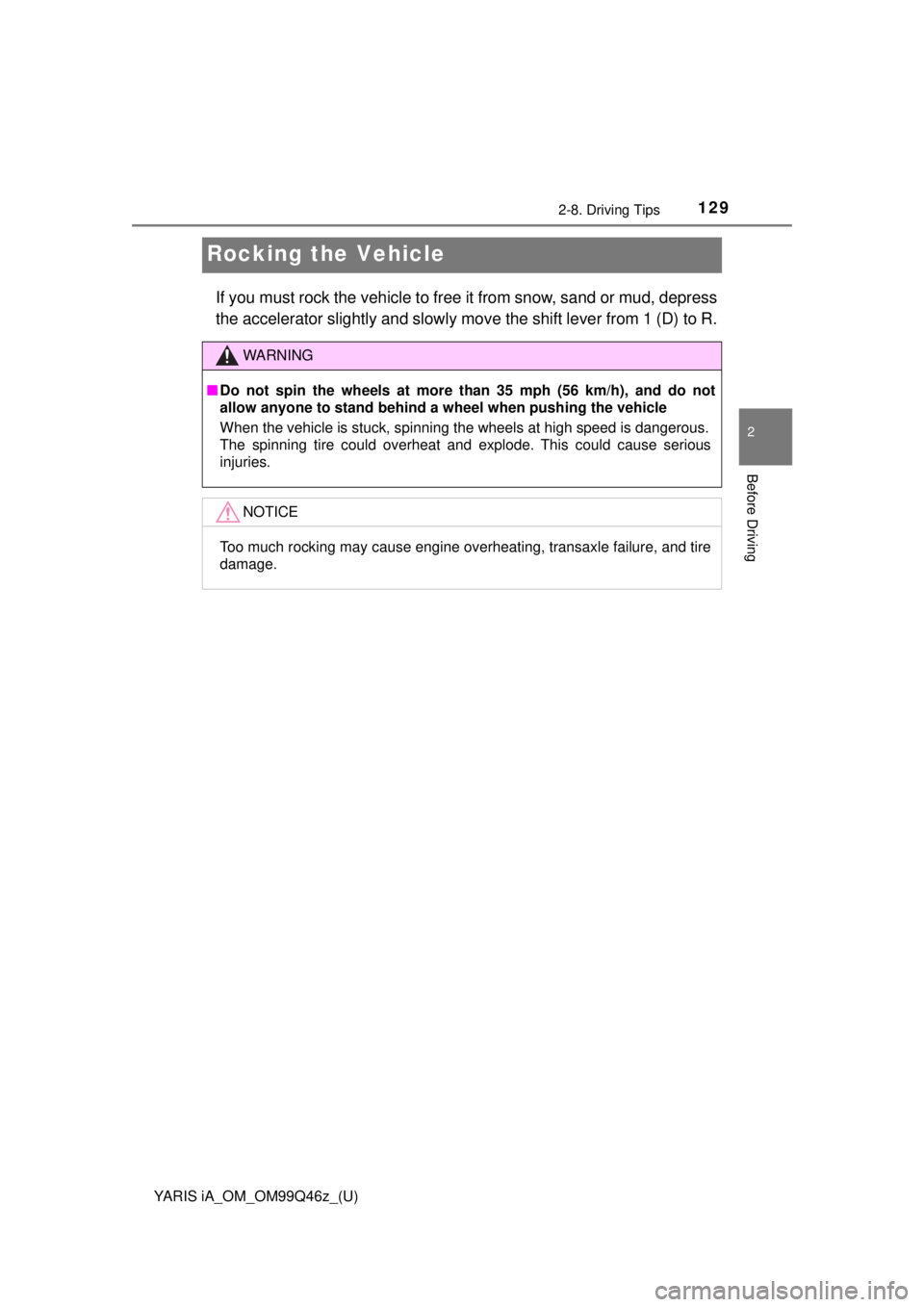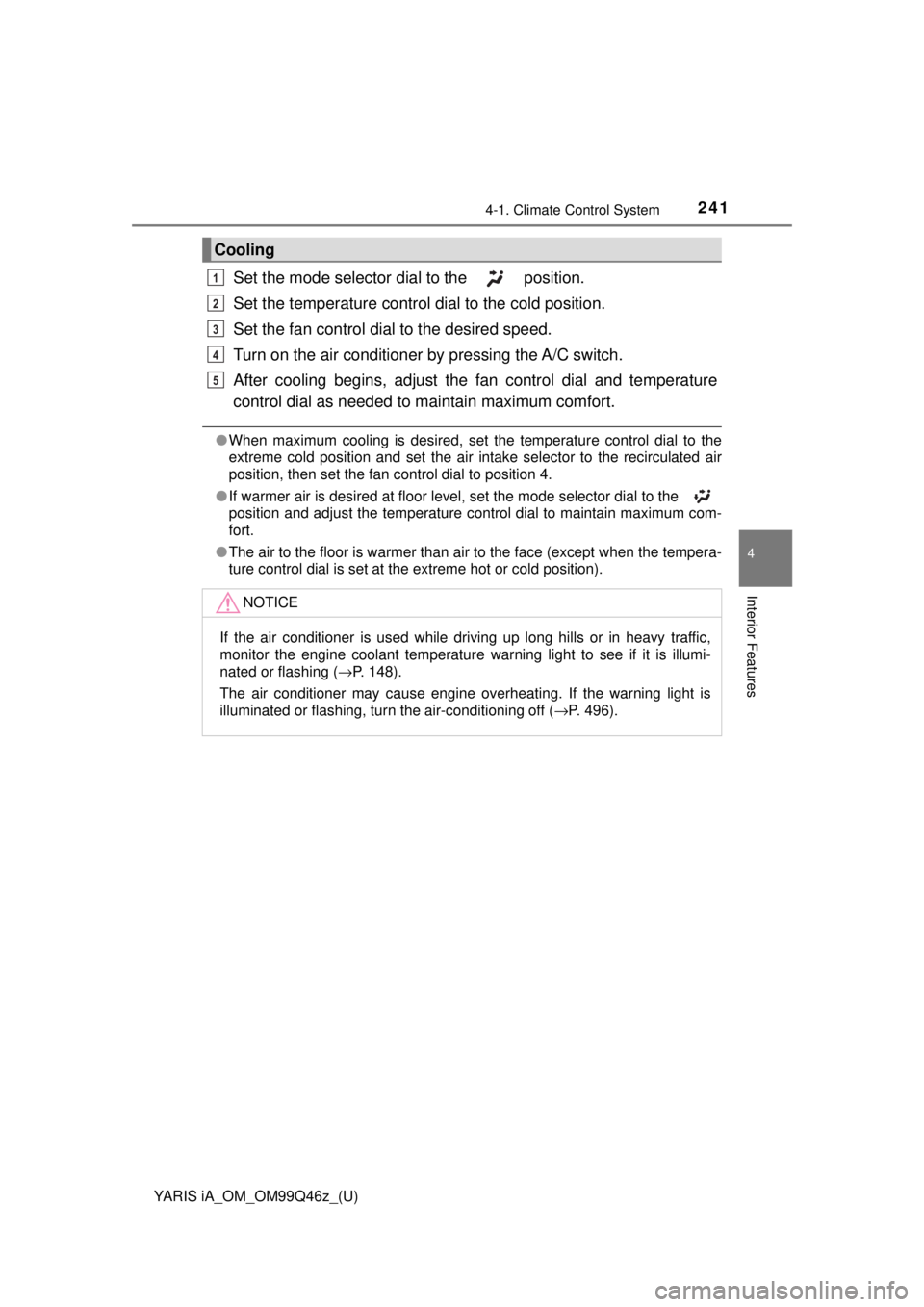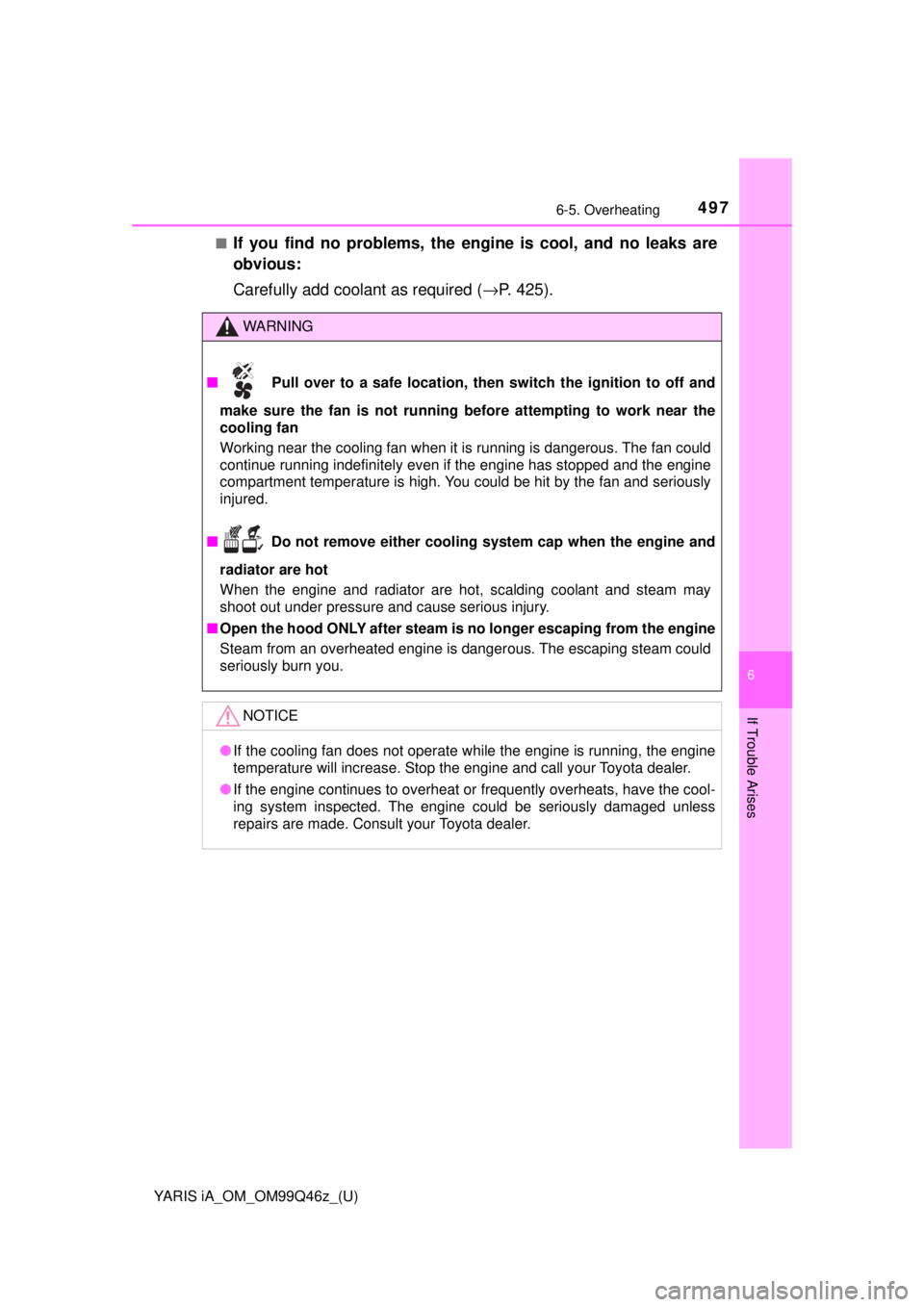2018 TOYOTA YARIS iA overheating
[x] Cancel search: overheatingPage 5 of 576

5
1
8 7
6 4 3
2
YARIS iA_OM_OM99Q46z_(U)
5
5-1. Essential InformationIntroduction ....................... 412
5-2. Scheduled Maintenance Maintenance Monitor......... 414
5-3. Owner Maintenance Owner Maintenance Precautions ..................... 417
Hood.................................. 419
Engine Compartment Overview ......................... 421
Engine Oil.......................... 422
Engine Coolant.................. 425
Brake/Clutch Fluid ............. 428
Window Washer Fluid ....... 429
Body Lubrication ............... 430
Wiper Blades ..................... 431
Battery ............................... 434
Key Battery Replacement ................... 436
Tires .................................. 439
Light Bulbs ........................ 445
Fuses ................................ 455
5-4. Appearance Care Exterior Care ..................... 462
Interior Care ...................... 470 6-1. Parking in an Emergency
Parking in an Emergency ...................... 476
6-2. Flat Tire Spare Tire and Tool Storage ............................ 477
Changing a Flat Tire .......... 481
6-3. Battery Runs Out Jump-Starting .................... 491
6-4. Emergency Starting Starting a Flooded Engine ............................. 494
Push-Starting ..................... 495
6-5. Overheating Overheating ....................... 496
6-6. Emergency Towing Towing Description ............ 498
Tiedown Hooks .................. 499
6-7. Warning/Indicator Lights and Warning Sounds
If a Warning Light Turns On or Flashes .................. 501
Message Indicated on Display............................. 512
Warning Sound is Activated.......................... 514
6-8. When Trunk Lid Cannot be Opened
When Trunk Lid Cannot be Opened....................... 517
5Maintenance and Care6If Trouble Arises
Page 129 of 576

129
YARIS iA_OM_OM99Q46z_(U)
2-8. Driving Tips
2
Before Driving
Rocking the Vehicle
If you must rock the vehicle to free it from snow, sand or mud, depress
the accelerator slightly and slowly move the shift lever from 1 (D) to R.
WARNING
■Do not spin the wheels at more th an 35 mph (56 km/h), and do not
allow anyone to stand behind a wheel when pushing the vehicle
When the vehicle is stuck, spinning the wheels at high speed is dangerous.
The spinning tire could overheat and explode. This could cause serious
injuries.
NOTICE
Too much rocking may cause engine overheating, transaxle failure, and tire
damage.
Page 174 of 576

174
YARIS iA_OM_OM99Q46z_(U)
3-3. Transaxle
■Passing
For extra power when passing another vehicle or climbing steep
grades, depress the accelerator fully. The transaxle will shift to a
lower gear, depending on vehicle speed.
Some models:
The accelerator pedal may initially feel heavy as it is being depressed,
then feel lighter as it is depressed further. This change in pedal force
aids the engine control system in determining how much the accelerator
pedal has been depressed for performing kickdown, and functions to
control whether or not kickdown should be performed.
■
Climbing steep grades from a stop
To climb a steep grade from a stopped position:
Depress the brake pedal.
Shift to D or M1, depending on the load weight and grade steep-
ness.
Release the brake pedal while gradually accelerating.
■Descending steep grades
When descending a steep grade, shift to lower gears, depending on
load weight and grade steepness. Descend slowly, using the
brakes only occasionally to pr event them from overheating.
Driving Tips
WARNING
■Do not let the vehicle move in a di rection opposite to the direction
selected by the selector lever
Do not let the vehicle move backward with the selector lever in a forward
position, or do not let the vehicle move forward with the selector lever in the
reverse position. Otherwise, the engine may stop, causing the loss of the
power brake and power steering functions , and make it difficult to control
the vehicle which could result in an accident.
1
2
3
Page 182 of 576

182
YARIS iA_OM_OM99Q46z_(U)
3-4. Switches and Controls
Windshield Wipers and Washer
The ignition must be switched ON to use the wipers.
Because heavy ice and snow can jam the wiper blades, the wiper motor is
protected from motor breakdown, overheating and possible fire by a circuit
breaker. This mechanism will automatically stop operation of the blades, but
only for about 5 minutes.
If this happens, turn off the wiper switch and park off the right-of-way, and
remove the snow and ice.
After 5 minutes, turn on the switch and the blades should operate normally. If
they do not resume functioning, consult your Toyota dealer as soon as possi-
ble. Drive to the side of the road and park off the right-of-way. Wait until the
weather clears before trying to drive with the wipers inoperative.
WARNING
■Use only windshield washer fluid or plain water in the reservoir
Using radiator antifreeze as washer fluid is dangerous. If sprayed on the
windshield, it will dirty the windshield, affect your visibility, and could result
in an accident.
■ Only use windshield washer fluid mixed with anti-freeze protection in
freezing weather conditions
Using windshield washer fluid without anti-freeze protection in freezing
weather conditions is dangerous as it could freeze on the windshield and
block your vision which could cause an accident. In addition, make sure the
windshield is sufficiently warmed using the defroster before spraying the
washer fluid.
Page 241 of 576

YARIS iA_OM_OM99Q46z_(U)
2414-1. Climate Control System
4
Interior Features
Set the mode selector dial to the position.
Set the temperature control dial to the cold position.
Set the fan control dial to the desired speed.
Turn on the air conditioner by pressing the A/C switch.
After cooling begins, adjust the fan control dial and temperature
control dial as needed to maintain maximum comfort.
● When maximum cooling is desired, set the temperature control dial to the
extreme cold position and set the air intake selector to the recirculated air
position, then set the fan control dial to position 4.
● If warmer air is desired at floor level, set the mode selector dial to the
position and adjust the temperature control dial to maintain maximum com-
fort.
● The air to the floor is warmer than air to the face (except when the tempera-
ture control dial is set at the extreme hot or cold position).
Cooling
NOTICE
If the air conditioner is used while driving up long hills or in heavy traffic,
monitor the engine coolant temperature warning light to see if it is illumi-
nated or flashing ( →P. 148).
The air conditioner may cause engine overheating. If the warning light is
illuminated or flashing, turn the air-conditioning off ( →P. 496).
1
2
3
4
5
Page 475 of 576

475
YARIS iA_OM_OM99Q46z_(U)
6If Trouble Arises
6-1. Parking in an EmergencyParking in an Emergency ...................... 476
6-2. Flat Tire Spare Tire and Tool Storage ........................... 477
Changing a Flat Tire ......... 481
6-3. Battery Runs Out Jump-Starting.................... 491
6-4. Emergency Starting Starting a Flooded Engine............................. 494
Push-Starting .................... 495
6-5. Overheating Overheating ...................... 496
6-6. Emergency Towing Towing Description ........... 498
Tiedown Hooks ................. 499
6-7. Warning/Indicator Lights and Warning Sounds
If a Warning Light Turns On or Flashes ................. 501
Message Indicated on Display ............................ 512
Warning Sound is Activated ......................... 514
6-8. When Trunk Lid Cannot be Opened
When Trunk Lid Cannot be Opened ...................... 517
Page 496 of 576

496
YARIS iA_OM_OM99Q46z_(U)
6-5. Overheating
Overheating
If the high engine coolant temperature warning light turns on:Drive safely to the side of the road and park off the right-of-way.
Put a vehicle with an automatic tr ansaxle in park (P), a manual tran-
saxle in neutral.
Apply the parking brake.
Turn off the air conditioner.
Check whether coolant or steam is escaping from the engine com-
partment.
If steam is coming from the engine compartment
Do not go near the front of the vehicle. Stop the engine.
Wait until the steam dissipates, then open the hood and start the
engine.
If neither coolant nor steam is escaping
Open the hood and idle the engine until it cools.
Make sure the cooling fan is operating, then turn off the engine after
the temperature has decreased.
When cool, check the coolant level.
If it is low, look for coolant leaks from the radiator and hoses.
■If you find a leak or other damage , or if coolant is still leaking:
Stop the engine and call your Toyota dealer.
Cooling fan
Cooling system cap
Coolant reservoir
If the high engine coolant temperature warning light turns on,
the vehicle loses power, or you hear a loud knocking or pinging
noise, the engine is probably too hot.
1
2
3
4
5
6
7
1
2
3
Page 497 of 576

YARIS iA_OM_OM99Q46z_(U)
4976-5. Overheating
6
If Trouble Arises
■If you find no problems, the engine is cool, and no leaks are
obvious:
Carefully add coolant as required (→P. 425).
WARNING
■ Pull over to a safe location, then switch the ignition to off and
make sure the fan is not running befo re attempting to work near the
cooling fan
Working near the cooling fan when it is running is dangerous. The fan could
continue running indefinitely even if the engine has stopped and the engine
compartment temperature is high. You could be hit by the fan and seriously
injured.
■ Do not remove either cooling system cap when the engine and
radiator are hot
When the engine and radiator are hot, scalding coolant and steam may
shoot out under pressure and cause serious injury.
■ Open the hood ONLY after steam is no longer escaping from the engine
Steam from an overheated engine is dangerous. The escaping steam could
seriously burn you.
NOTICE
● If the cooling fan does not operate while the engine is running, the engine
temperature will increase. Stop the engine and call your Toyota dealer.
● If the engine continues to overheat or frequently overheats, have the cool-
ing system inspected. The engine could be seriously damaged unless
repairs are made. Consult your Toyota dealer.